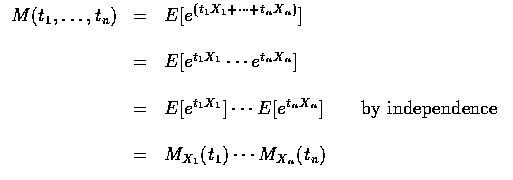![$\begin{array}{rcl}
M_{X+Y}&=&E[e^{t(X+Y)}] \\ \\
&=&E[e^{tX}e^{tY}] \\ \\
&=&E[e^{tX}]E[e^{tY}] \\ \\
&=&M_X(t)M_Y(t)
\end{array}$](img1.gif)
Property of Moment Generating Function
An important property of moment generating functions is that the moment generating function of the sum of independent random variables equals the product of the individual moment generating functions. To prove this, suppose that X and Y are independent and have moment generating functions MX(t)and MY(t), respectively. Then MX+Y(t), the moment generating function of X+Y, is given by
![$\begin{array}{rcl}
M_{X+Y}&=&E[e^{t(X+Y)}] \\ \\
&=&E[e^{tX}e^{tY}] \\ \\
&=&E[e^{tX}]E[e^{tY}] \\ \\
&=&M_X(t)M_Y(t)
\end{array}$](img1.gif)
It is also possible to define the joint moment generating function of two or
more random variables. This is done as follows. For any n random variables
![]() ,
the joint moment generating function,
,
the joint moment generating function,
![]() ,
is
defined for all real values of
,
is
defined for all real values of
![]() by
by
It can be proved (although the proof is too advanced for this text) that
![]() uniquely determines the joint distribution of
uniquely determines the joint distribution of
![]() .
This result can then be used to prove that the n random
variables
.
This result can then be used to prove that the n random
variables
![]() are independent if and only if
are independent if and only if
